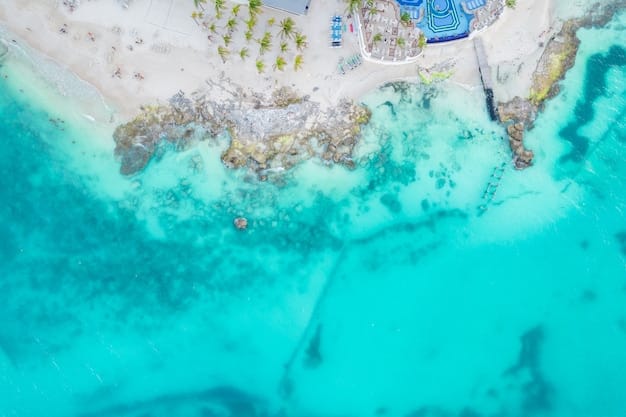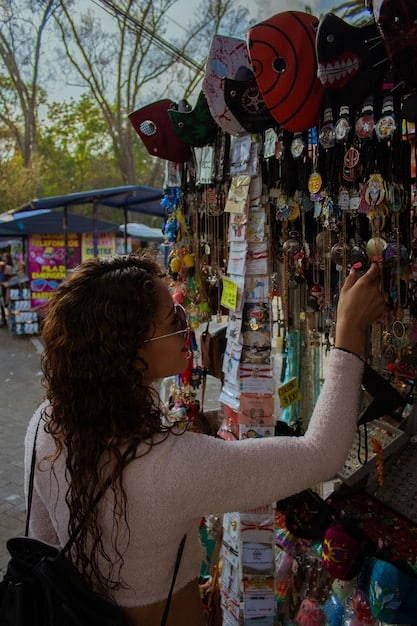Mexico’s Tourism Sector Sees 15% Growth: Where Are Americans Traveling?

Mexico’s tourism sector has experienced a robust 15% growth, largely driven by American travelers seeking diverse cultural experiences, pristine beaches, and vibrant cities, solidifying its position as a top international destination.
The Mexican tourism sector is experiencing a significant boom, with a notable 15% growth that underscores its enduring appeal. This surge is particularly propelled by visitors from the United States, raising an important question: Mexico’s tourism sector sees 15% growth: where are Americans traveling? Understanding these travel patterns offers valuable insights into the evolving landscape of international tourism and highlights the diverse attractions that draw travelers south of the border.
The Resurgence of Mexican Tourism: A Deep Dive into Growth
Mexico’s tourism industry has long been a cornerstone of its economy, and recent figures showcasing a 15% growth are a testament to its resilience and adaptive capacity. This growth is not merely a statistical anomaly but reflects a strategic pivot and enhanced appeal to a global audience, particularly from its northern neighbor. The country’s unique blend of cultural heritage, natural beauty, and modern amenities positions it as a premier destination.
Several factors contribute to this impressive rebound, including robust marketing campaigns, improved air connectivity, and a perception of safety and value that resonates with international travelers. The Mexican government, along with private sector stakeholders, has invested significantly in infrastructure and tourism products, enhancing the overall visitor experience. This commitment to quality and diversity has clearly paid dividends.
Strategic Initiatives Driving Growth
The consistent growth in Mexico’s tourism sector is no accident; it is the result of deliberate and well-executed strategies. These initiatives often involve multi-pronged approaches aimed at attracting a wider demographic and extending the average length of stay for visitors.
- Enhanced Connectivity: New direct flights and increased frequency from major US cities have made Mexico more accessible than ever.
- Sustainable Tourism: Focus on eco-friendly practices and supporting local communities appeals to conscious travelers.
- Digital Nomad Programs: Initiatives designed to attract remote workers for longer stays contribute to sustained growth beyond traditional tourism.
The focus on sustainable practices, for instance, not only preserves Mexico’s natural wonders but also appeals to a growing segment of environmentally aware tourists. Furthermore, the diversification of tourism offerings beyond traditional beach destinations to include cultural, adventure, and gastronomic experiences has broadened its market appeal. This holistic approach ensures that Mexico caters to a varied array of interests, reinforcing its market position.
Moreover, the seamless travel processes and the relatively straightforward entry requirements for US citizens also play a crucial role. Mexico has maintained an open-door policy for tourism, even during challenging global periods, which has fostered trust and reliability among potential visitors. This consistent approach has allowed the country to capitalize on pent-up demand for international travel, making it a preferred choice for many Americans seeking an escape or adventure.
The collaboration between federal and state tourism boards, along with local communities, has been instrumental in crafting authentic and engaging experiences that go beyond typical tourist traps. By highlighting regional specialties, traditions, and natural wonders, Mexico offers a depth of experience that encourages repeat visits and positive word-of-mouth recommendations, further fueling the growth trajectory.
American Hot Spots: Unveiling Popular Mexican Destinations
When Americans choose Mexico, they are looking for a diverse range of experiences, from sun-soaked beaches to vibrant urban adventures and ancient historical sites. The 15% growth in Mexico’s tourism sector is heavily influenced by their preferences, with several key destinations standing out as perennial favorites. These hotspots offer a microcosm of Mexico’s appeal, combining accessibility with unforgettable holiday opportunities.
Coastal areas remain incredibly popular, drawing visitors with their promise of relaxation and adventure. However, there’s a growing trend towards exploring Mexico’s rich cultural tapestry, leading to increased interest in its colonial cities and archaeological wonders. This diversification reflects a more sophisticated American traveler base, eager to delve deeper into the country’s heritage.
Mexico’s Coastal Gems and Cultural Hubs
The allure of Mexico’s coasts is undeniable, with destinations like Cancun and Playa del Carmen continually topping the list for American travelers. These areas epitomize the classic Mexican beach vacation, offering luxurious resorts, pristine waters, and a plethora of activities. Yet, the appeal extends far beyond just sand and sun.
- Cancun/Riviera Maya: Known for all-inclusive resorts, clear waters, and proximity to Mayan ruins like Chichen Itza.
- Los Cabos: A favorite on the Baja California peninsula, offering luxury, golf, and vibrant nightlife, popular with West Coast travelers.
- Puerto Vallarta: Mixing traditional Mexican charm with modern amenities, appealing to families and couples alike.
Beyond the beaches, cities like Mexico City and San Miguel de Allende are gaining significant traction. Mexico City, a sprawling metropolis, offers an unparalleled dive into history, art, and gastronomy. Its world-class museums, historic neighborhoods, and innovative culinary scene provide a stark contrast to the beach resort experience, appealing to those seeking urban exploration and cultural immersion.
San Miguel de Allende, a UNESCO World Heritage site, is celebrated for its well-preserved colonial architecture, cobblestone streets, and thriving arts scene. Its tranquil beauty and artistic community have made it a magnet for American retirees and creatives. These cultural hubs demonstrate that American travelers are increasingly valuing authentic experiences that go beyond typical tourist itineraries, contributing significantly to the sector’s growth.
Moreover, the concept of “bleisure” travel—combining business with leisure—is also driving visitation to cities capable of hosting conferences and offering compelling recreational opportunities. The robust tourism infrastructure in these key destinations, from high-end accommodation to diverse dining options and efficient transportation, further cements their status as top choices for American visitors. This strategic variety ensures appeal across different age groups and travel motivations.
The Economic Impact: How American Travelers Fuel Mexico’s Growth
The 15% growth in Mexico’s tourism sector is profoundly linked to the spending habits and travel trends of American tourists. Their significant contribution goes beyond mere visitation numbers, acting as a crucial engine that drives economic activity across various sectors of the Mexican economy. Understanding this symbiotic relationship is key to appreciating the full scope of their impact.
Each dollar spent by an American traveler, whether on accommodation, dining, tours, or local crafts, ripples through the economy. This direct spending supports countless jobs, from hotel staff and tour guides to artisans and restaurant workers, sustaining livelihoods and fostering local enterprise. The multiplier effect means that the initial spending generates further economic activity as money circulates within the country.
Financial Contributions and Job Creation
The financial influx from American tourism supports a vast network of businesses and service providers. This includes not only those directly involved in tourism but also ancillary industries that supply goods and services to the hospitality sector. The demand generated by tourism often stimulates investment and innovation, leading to better services and new opportunities.
- Direct Spending: Covers lodging, food, transportation, and souvenirs, directly benefiting businesses.
- Indirect Contributions: Supports suppliers to the tourism industry, from food producers to construction companies.
- Induced Economic Activity: Employees in the tourism sector spend their wages, further stimulating demand in local economies.
Beyond direct financial transactions, the robust flow of American tourists often encourages foreign direct investment (FDI) into Mexico’s tourism infrastructure. This includes the building of new resorts, development of new attractions, and upgrading of transportation networks, all of which create more jobs and improve the overall visitor experience. This continuous cycle of investment and growth signifies a healthy and expanding sector.

Furthermore, the high demand from American tourists allows for more consistent flight routes and competitive pricing, making travel even more accessible. This stability benefits not just the tourism industry but also supports the aviation sector, which is critical for international connectivity. The relationship is a virtuous circle: as more Americans visit, the infrastructure to support them improves, making Mexico an even more attractive destination.
The substantial economic contribution also empowers local communities, giving them the resources to preserve their cultural heritage and natural environments. Tourism revenues can be reinvested in educational programs, healthcare facilities, and infrastructure improvements, directly enhancing the quality of life for residents. This long-term sustainable development makes American tourism a powerful force for positive change in Mexico, far beyond just vacations.
Experiences Sought: Beyond Beaches and into Culture
While Mexico’s stunning beaches have undeniably been a major draw for American travelers, the 15% growth in its tourism sector reveals a fascinating evolution in what visitors seek. There’s a noticeable shift towards deeper engagement with Mexican culture, history, and natural wonders, moving beyond the traditional sun-and-sand vacation. This growing interest in authentic experiences enriches the travel landscape and broadens Mexico’s appeal.
Americans are increasingly curious about Mexico’s pre-Hispanic civilizations, colonial heritage, vibrant arts scene, and renowned culinary traditions. This desire for cultural immersion has led to a diversification of popular destinations and a demand for more bespoke, enriching itineraries. The narrative is no longer just about relaxation but also about discovery and personal growth.
Embracing Authenticity and Adventure
The modern American traveler is often in pursuit of authenticity, moving away from cookie-cutter resort experiences towards opportunities for genuine connection with local life. This includes exploring indigenous communities, participating in traditional workshops, and venturing into lesser-known regions.
- Gastronomic Journeys: Food tours and cooking classes exploring regional Mexican cuisines like Oaxacan or Puebla’s flavors.
- Historical Exploration: Visits to ancient Mayan ruins, Aztec temples, and well-preserved colonial cities such as Guanajuato and Merida.
- Nature and Adventure: Eco-tourism in biosphere reserves, exploring cenotes, jungle treks, and marine activities like whale watching.
The rise of food tourism, for example, is a significant trend. American visitors are eager to explore Mexico’s diverse culinary landscape, participate in authentic cooking classes, and visit local markets. This deep dive into gastronomy offers a tangible way to connect with the culture and traditions of various regions, moving beyond typical restaurant dining to an educational and sensory experience.
Furthermore, interest in archaeological sites like Teotihuacan, Chichen Itza, and Palenque continues to grow. These ancient cities provide a captivating glimpse into Mexico’s rich pre-Columbian history, offering a profound sense of wonder and connection to the past. The demand for knowledgeable guides and well-preserved sites ensures that these historical journeys are both educational and awe-inspiring.
Adventure tourism is also flourishing, with Americans seeking out activities that get them closer to Mexico’s natural beauty. From exploring the geological marvels of cenotes in the Yucatán Peninsula to hiking in Copper Canyon, or engaging in marine activities along the coasts, these experiences offer thrill and a unique perspective. This blend of cultural and adventure pursuits paints a picture of a more engaged and curious American traveler, driving the diversified growth of Mexico’s tourism sector.
Safety, Infrastructure, and Accessibility: Key Pillars of Attraction
The impressive 15% growth in Mexico’s tourism sector for American travelers is not solely attributable to its inherent beauty and cultural richness. Fundamental to this success are the continuous improvements in safety, the robust development of tourism infrastructure, and enhanced accessibility. These three pillars underpin a reliable and appealing travel experience, fostering confidence among potential visitors.
Perceptions of safety are paramount for international travel decisions, and Mexico has made concerted efforts to ensure the security of major tourist corridors. Simultaneously, investments in modern infrastructure, including airports, roads, and digital connectivity, have made traveling within the country more comfortable and efficient. Coupled with increasingly accessible air routes, these factors collectively enhance Mexico’s competitive edge.
Ensuring a Seamless and Secure Journey
Travelers seek peace of mind, and Mexico’s commitment to improving safety measures in popular tourist zones has been critical. This includes increased presence of security personnel, rapid response systems, and collaboration with international agencies to address any concerns. The result is a greater sense of security for visitors, which is openly communicated through various travel advisories and local information.
- Enhanced Security Measures: Increased vigilance and resources in high-tourism areas to ensure visitor safety.
- Modernized Transportation: Upgraded airports, highways, and public transport systems simplify travel within Mexico.
- Health and Safety Protocols: Adherence to international health guidelines, especially in the post-pandemic era, builds trust.
Beyond security, the continuous upgrade of tourism infrastructure significantly contributes to visitor satisfaction. This includes not just modern airports and reliable road networks but also a wide range of accommodation options, from luxury resorts to boutique hotels and eco-lodges, catering to diverse preferences and budgets. The availability of high-quality services, including healthcare facilities and emergency services, further instills confidence in travelers.
Accessibility is also a key factor. The proliferation of direct flights from numerous US cities to major Mexican destinations means less travel time and more convenience for American tourists. Budget airlines and competitive pricing strategies have also made international travel to Mexico more affordable for a wider demographic. This ease of access significantly lowers the barriers to entry, encouraging more frequent visits.
Furthermore, digital infrastructure, including widespread Wi-Fi access in hotels and tourist areas, enables seamless communication and navigation for travelers. This digital connectivity allows visitors to share their experiences in real-time, influencing others and contributing to Mexico’s perceived appeal as a modern and welcoming destination. The synergy of safety, infrastructure, and accessibility creates an environment where tourism can thrive, cementing Mexico’s status as a top choice for American travelers.
Future Outlook and Emerging Trends in Mexican Tourism
The 15% growth in Mexico’s tourism sector is an impressive milestone, but the industry is not resting on its laurels. Looking forward, several emerging trends and strategic initiatives are poised to shape the future of tourism in Mexico, particularly concerning American travelers. The focus is increasingly on sustainability, diversification, and personalized experiences to ensure continued growth and relevance in a competitive global market.
There’s a clear recognition that while traditional attractions remain popular, the future lies in catering to more niche interests and responsible travel. This involves developing new tourism products, investing in green infrastructure, and leveraging technology to enhance visitor engagement. The goal is to evolve the tourism offering to meet the changing expectations of the modern traveler.
Innovations and Sustainable Practices
The push for sustainable tourism is becoming more pronounced, driven by both consumer demand and environmental imperatives. This includes developing eco-friendly resorts, promoting conservation efforts, and fostering community-based tourism that directly benefits local populations while minimizing environmental impact.
- Eco-Tourism Expansion: Development of new nature-based attractions and experiences that prioritize environmental preservation.
- Digital Transformation: Use of AI and personalized apps to enhance booking experiences, provide localized recommendations, and streamline travel.
- Wellness Tourism: Growth in retreats, spas, and health-focused travel, tapping into a growing market of health-conscious individuals.
Beyond sustainability, there’s a concerted effort to diversify tourism beyond the well-trodden paths. This involves promoting lesser-known regions, highlighting unique cultural festivals, and developing specialized tours focusing on gastronomy, art, or adventure sports. The aim is to spread tourism benefits more broadly across the country and offer repeat visitors new reasons to return.

Technological integration is also a key aspect of future growth. From virtual reality tours that inspire travel to AI-powered chatbots that assist with bookings and inquiries, technology is being harnessed to improve the travel experience from planning to execution. Enhanced digital connectivity will also support the growing trend of digital nomads, allowing them to work and travel seamlessly within Mexico.
Furthermore, wellness tourism is an increasingly important segment, with Mexico well-positioned to capitalize on its natural landscapes and ancient healing traditions. Resorts offering yoga retreats, holistic treatments, and healthy living programs are attracting a distinct demographic seeking rejuvenation and mindful travel experiences. These forward-thinking strategies ensure that Mexico remains at the forefront of international tourism, continuing to captivate and draw American travelers for years to come.
Addressing Challenges and Ensuring Sustainable Growth
While Mexico’s tourism sector rejoices in a commendable 15% growth, especially from American travelers, sustaining this momentum requires addressing existing and potential challenges proactively. The focus must be on maintaining a delicate balance between growth, environmental preservation, and social equity. This commitment ensures that the benefits of tourism are shared widely and that the industry remains resilient against future disruptions.
Challenges typically include managing environmental degradation in popular areas, mitigating the impact of over-tourism, and ensuring that economic benefits truly reach local communities. Moreover, the dynamic global landscape requires continuous adaptation to evolving travel preferences and geopolitical shifts. A comprehensive and adaptive strategy is essential for long-term success.
Mitigation Strategies and Community Engagement
Effective management of tourist destinations is crucial to prevent the negative consequences associated with rapid growth. This includes implementing stricter environmental regulations, promoting responsible tourism practices among visitors, and investing in waste management and resource conservation initiatives. The aim is to protect Mexico’s natural assets which are fundamental to its tourism appeal.
- Environmental Protection: Strict regulations to protect natural sites, marine life, and sensitive ecosystems from tourist impact.
- Community Beneficiation: Programs that ensure local communities directly benefit from tourism, through job creation, cultural exchange, and infrastructure development.
- Diversification of Offerings: Spreading tourist load by promoting lesser-known destinations and specialized tours to prevent over-tourism in popular areas.
Another significant challenge is ensuring that the economic gains from tourism are equitably distributed. This involves fostering local entrepreneurship, supporting small and medium-sized businesses, and providing training opportunities for residents to participate effectively in the tourism value chain. Empowering local communities strengthens the social fabric and creates a more inclusive tourism economy.
Additionally, adapting to global health and economic fluctuations is vital. This requires building robust crisis management frameworks, maintaining open communication with international partners, and diversifying source markets to reduce reliance on any single country. The resilience shown during recent global events highlights Mexico’s capacity to adapt, but continuous vigilance and planning are necessary.
Ultimately, a collaborative approach involving government agencies, private sector stakeholders, local communities, and tourists themselves is critical for ensuring sustainable growth. By fostering a shared responsibility for conservation, cultural preservation, and equitable development, Mexico can maintain and enhance its position as a world-leading tourism destination, benefiting both visitors and its citizens for generations to come.
| Key Aspect | Brief Description |
|---|---|
| 📈 Growth Rate | The Mexican tourism sector experienced a significant 15% growth. |
| ✈️ US Traveler Focus | American tourists are a primary driver of this impressive growth. |
| 🏖️ Popular Destinations | Coastal resorts (Cancun, Los Cabos) and cultural cities (Mexico City, San Miguel de Allende) are hotspots. |
| 💡 Future Trends | Emphasis on sustainable tourism, cultural immersion, and wellness travel. |
Frequently Asked Questions About Mexico’s Tourism Boom
▼
The growth is primarily driven by increased accessibility through new flight routes, effective marketing campaigns highlighting Mexico’s diverse offerings, and a perception of excellent value for money. Strategic investments in infrastructure and a focus on both traditional beach destinations and cultural/adventure tourism have also played a significant role in attracting a wide range of visitors, especially from the US.
▼
American travelers continue to flock to coastal destinations like Cancun, Riviera Maya, Los Cabos, and Puerto Vallarta for their sun, sand, and resort experiences. However, there’s growing interest in cultural hubs such as Mexico City and San Miguel de Allende, which offer rich historical sites, vibrant arts scenes, and diverse culinary experiences, indicating a broader appeal beyond beaches.
▼
American tourism has a substantial positive impact, fueling direct spending on accommodations, dining, and activities, which supports numerous jobs in the hospitality and related sectors. It also drives indirect economic activity by boosting demand for suppliers and services to the tourism industry. Furthermore, it encourages foreign direct investment in tourism infrastructure, leading to long-term economic growth and development across communities.
▼
Yes, there’s a noticeable shift beyond just beach holidays. More American travelers are seeking authentic cultural experiences, including gastronomic tours, historical explorations of ancient ruins and colonial cities, and nature-based adventures like eco-tourism. This desire for deeper engagement with Mexican culture and natural beauty enriches their travel and diversifies the tourism offerings, contributing to broader sector growth.
▼
Mexico is increasingly focused on sustainable practices, including environmental protection measures for natural sites, promoting responsible tourism, and investing in green infrastructure. There’s also an emphasis on community engagement to ensure local populations benefit directly from tourism and prevent over-tourism in popular areas. These efforts aim to balance economic growth with environmental and social responsibility for long-term sustainability.
Conclusion
The remarkable 15% growth in Mexico’s tourism sector, especially propelled by American travelers, underscores the nation’s successful blend of strategic development, diverse attractions, and an unwavering commitment to enhancing visitor experiences. From the sun-drenched coasts to the vibrant cultural hubs and ancient ruins, Mexico continues to captivate a broad spectrum of travelers. Looking ahead, a sustained focus on safety, infrastructure, and evolving visitor preferences, alongside robust sustainable practices, will be pivotal in ensuring Mexico remains a top-tier international destination. This dynamic growth is not merely a transient phenomenon but a testament to a resilient and forward-looking tourism industry.





